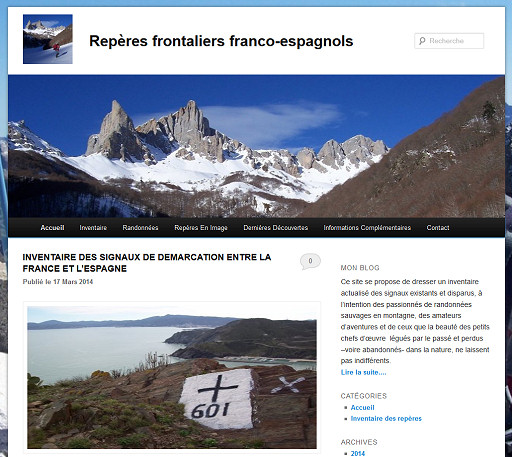Jacques Koleck (see previous post) surprised me by his pictures of bordercross 251, taken in 2008. We know that in the 19th century a cross 251 was engraved but – being replaced by the current borderstone 251 – I assumed that this cross was lost. Charles and Josette Darrieu searched for it but couldn’t find it. See this page on my website.
But Jacques shows that it still existed in 2008 and Charles Darrieu sent a picture of Javier Sancho, dating from june 2012. And I will gladly return to make my own pictures. But where is this cross located? Comparing the various pictures with Google Earth and my own footage results in a most likely spot. But first the pictures of Jacques:
We’re looking to the west to the Port de Belhay where bm250 is located. Note the small darkgreen hilltop to the right which is visible at Google Earth. That makes it easy to determine a straight line (approx. west-east) from Port de Belhay to this cross somewhere in the rockslide.
And on this second picture, we are necessarily looking south-east because of the other angle we see the cross but the picture gives no other clue. But the picture Charles sent me, made it possible to draw another line. And where those two lines intersect ……
And where those two lines intersect ……
But first an overview from Google Earth (note: compass direction reversed -> South is up). Remarkable: the yellow borderline (according to GE) is south of the actual bm251. A question for later: where is the official border?
As said before, the crossing of the two straight lines should be the spot of cross 251. According to Google Earth it’s ± 50m to the SE (which is “NW” on this picture) of bm251. Jacques Koleck remembered that the cross was close to the old trail (not the red/white waymarked trail higher up) and on a “considerable” distance from bm251.
And finally an overview, as seen from Port de Belhay. Having watched this overview, Jacques Koleck added this information: “I think the cross is in the lower part of the circle, above the “old trail” and 20 meters of a large rock well visible on my photo with the Port de Belhay in the background. The cross “looks” east and is probably on a straight line between the stone marker 251 and the cross 252.” The 252-cross is just behind the lower end of the ridge, directly behind the circle.

















